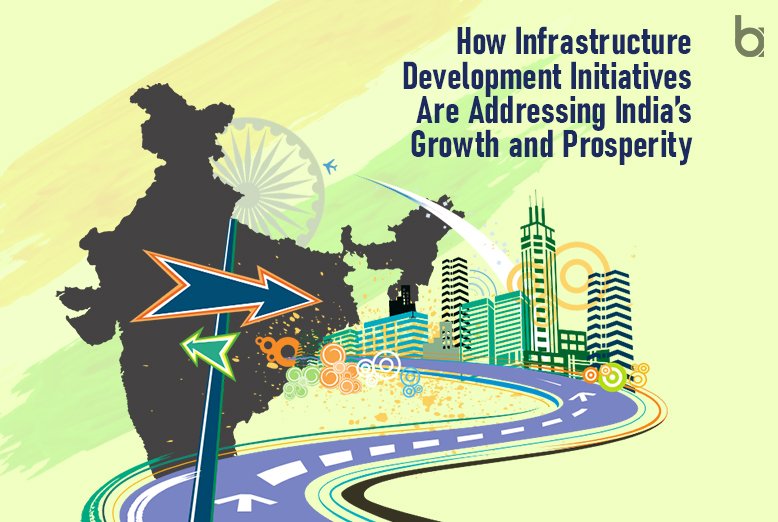Do you know how India’s infrastructure development is boosting the nation’s economic growth?
If you follow geopolitics and macroeconomics, then you might know that India is the fifth-largest economy in the world. Soon enough, it is going to become the third-biggest with a GDP of $5 trillion.
To achieve this ambitious goal, India needs to invest heavily in its infrastructure development, which is vital for its growth and prosperity.
This article highlights the following points:
- The Market Size
- Why India Needs Infrastructure Development
- Challenges
- Opportunities
- Project List
- Conclusion
The Booming Infrastructure Market: India’s Growth Engine
Mordor Intelligence estimates that the Indian infrastructure sector market will be worth USD 204.06 billion by 2024. Furthermore, it is predicted to reach USD 322.27 billion by 2029, expanding at a CAGR of 9.57% over the forecast period (2024–2029).
According to the IBEF report, urbanization, industrialization, and digitization are the primary areas boosting demand for infrastructure development in India. Further, it has also mentioned some staggering numbers that support the predicted potential growth of the Indian economy.
Infrastructure development is a top priority for the government. They’ve launched several initiatives recently. One of them is the US$ 1.3 trillion national master plan, Gati Shakti. This plan is leading the way in bringing about effective reforms in the sector. Already, it’s making significant progress.
Meanwhile, Saudi Arabia has shown interest in India’s growth. They plan to invest up to US$ 100 billion in various sectors. These include energy, petrochemicals, refineries, infrastructure, agriculture, minerals, and mining.
In the 2023-24 budget, there’s a notable increase in capital investment for infrastructure. It’s being raised by 33% to Rs. 10 lakh crore (US$ 122 billion). This investment will account for 3.3 percent of GDP. The Union Budget for the same year has allocated Rs. 2.40 lakh crore (US$ 29 billion) for the railways. This is the highest-ever outlay, about 9 times more than in 2013-14. It’s clear that infrastructure development is seen as a key driver of India’s growth and prosperity.
The infrastructure sector encompasses various sub-segments, each playing a vital role in the nation’s development. These include:
- Transportation: Roads, railways, airports, ports, and urban transportation systems.
- Energy: Power generation, transmission, and distribution, along with renewable energy sources.
- Communication: Telecommunications infrastructure, including internet connectivity and mobile networks.
- Social infrastructure: Education institutions, healthcare facilities, and water and sanitation systems.
Why Does India Need Extensive Infrastructure Development?
India is a diverse country with a population of over 1.4 billion people. To cater to that large population, it has to have a well-organized infrastructure. India’s economy runs on four crucial economic pillars: IT, finance, tourism, and healthcare.
A report published by S&P Global in 2016 stated, “India’s ambition to sustain its relatively high growth hinges on one crucial factor: infrastructure. However, the country faces a significant challenge due to its weak infrastructure, which is inadequate to meet the needs of a growing economy and population.”
Now that the government is focusing on inclusive development, economic diversification has begun on a larger scale. The main focus is on developing MSME sectors. It even aims to increase defense equipment manufacturing.
All these efforts are aimed at the following three key segments:
1. Economic Growth
First, infrastructure development facilitates the efficient movement of goods, attracts investments, and boosts overall economic activity. For example, better roads and railways can reduce transportation costs and time, increase trade and commerce, and create new markets and opportunities.
Similarly, reliable power and water supply can improve the productivity and competitiveness of industries and businesses. Moreover, infrastructure development can also generate employment and income for millions of people, especially in the construction and related sectors.
2. Social Development
Second, infrastructure development improves access to essential services like healthcare, education, and employment, contributing to social progress. For example, improved infrastructure can enable better delivery of health and education services, especially in rural and remote areas, and improve the quality and outcomes of these services.
Likewise, improved infrastructure can also create more and better job opportunities for people, especially youth and women, and reduce poverty and inequality.
3. Regional Growth
Third, infrastructure development can lead to balanced and inclusive growth across different regions of the country. For example, infrastructure development can bridge the gap between urban and rural areas, and between developed and underdeveloped states, by providing equal opportunities and benefits to all.
Furthermore, infrastructure development can also promote regional integration and cooperation, by connecting India with its neighboring countries and enhancing its role in the global arena.
Top 6 Challenges Faced in Infrastructure Development
With more than a billion people in the country, challenges are evident in growth. The list goes as follows:
1. Lack of Funding
Infrastructure development requires substantial financial resources. In India, the challenge is often the scarcity of these funds. The government, despite its best efforts, may struggle to allocate sufficient resources for infrastructure projects.
This can be due to budget constraints or competing priorities. It’s crucial to explore alternative funding sources, like public-private partnerships, to ensure continuous growth and expansion of infrastructure.
2. Environmental Concerns
Infrastructure development can have significant environmental impacts. Projects in sensitive areas or natural habitats need careful planning. The concern is about preserving biodiversity and preventing environmental degradation.
For instance, constructing a dam might disrupt local ecosystems. Therefore, environmental impact assessments are vital before starting any project. It ensures that development activities are environmentally sustainable.
3. Inefficient Decision-Making
The decision-making process for infrastructure development can sometimes be slow and inefficient. Bureaucratic red tape, political indecision, or lack of support can stall projects. For example, a highway project might face delays due to land acquisition issues or environmental clearances. Streamlining decision-making processes and ensuring the timely execution of projects is essential for effective infrastructure development.
4. Inadequate skilled labor
There is a shortage of adequately skilled labor in India for infrastructure development projects. This lack of skilled manpower can lead to delays in project completion, compromising the quality and efficiency of the infrastructure being built.
Enhancing the skill development programs and investing in training initiatives can help bridge this gap and improve the workforce’s capabilities.
5. Coordination among stakeholders
Effective coordination among various stakeholders, including government agencies, private sector entities, local communities, and regulatory bodies, is essential for successful infrastructure development. Lack of coordination can lead to conflicts, delays, and inefficiencies in project implementation.
Strengthening collaboration mechanisms, establishing clear communication channels, and promoting transparency can improve coordination efforts and streamline infrastructure development processes.
6. Land acquisition issues
Acquiring land for infrastructure projects can be complex and time-consuming in India. Legal hurdles, disputes over land ownership, and resistance from local communities can delay project timelines significantly.
Developing transparent land acquisition policies, engaging with stakeholders early in the process, and ensuring fair compensation mechanisms are essential to mitigate land acquisition challenges and expedite project implementation.
Opportunities to Grab
As we discussed challenges, there are opportunities in certain sectors to catch before you miss the ship. It has options like green energy, food processing units, eco-friendly products, shipping and logistics, etc. The list goes as follows:
Business-Specific Green Energy Opportunities in India
- Decentralized Solar Power: Focus on rooftop solar installations for homes, businesses, and institutions. Partner with local players for easier installation and maintenance services.
- Green Hydrogen Production: Invest in manufacturing electrolyzers and setting up renewable energy-powered plants to produce green hydrogen for transportation and industrial use.
- Waste-to-Energy Plants: Establish facilities that convert municipal solid waste or agricultural residue into biogas or electricity, promoting cleaner waste management solutions.
- Energy Storage Solutions: Develop and supply battery storage systems for solar and wind power plants, enabling grid integration and peak power management.
- Green Building Consultancy: Offer expertise in sustainable building design and materials for energy-efficient commercial and residential structures.
New Rail Project Opportunities
- High-Speed Rail Development: Participate in building consortiums or supplying technology for high-speed rail corridors connecting major cities, improving travel time significantly.
- Railway Electrification: Contribute to projects converting diesel locomotive operations to electric ones, reducing emissions and improving efficiency.
- Smart Railway Infrastructure: Develop and implement intelligent transportation systems for improved traffic management, passenger information, and operational efficiency.
- Railway Station Redevelopment: Partner in projects for modernizing railway stations with improved amenities, retail spaces, and better connectivity.
- Freight Logistics Solutions: Design and implement innovative containerization or logistics solutions to streamline freight movement on the railway network.
Manufacturing Unit Opportunities
- Electric Vehicle (EV) Components: Set up manufacturing units for EV batteries, motors, charging stations, or other crucial components catering to the growing EV industry.
- Green Building Materials: Manufacture eco-friendly construction materials like recycled steel, bamboo composites, or energy-efficient insulation for sustainable buildings.
- Renewable Energy Equipment: Focus on building solar panels, wind turbines, or other equipment needed for renewable energy projects, capitalizing on India’s clean energy push.
- Precision Manufacturing: Establish facilities for high-precision components used in electronics, medical devices, or aerospace, leveraging India’s skilled workforce.
- Food Processing Units: Invest in modern food processing and storage facilities to reduce wastage, improve shelf life, and cater to the rising demand for processed food exports.
Goods Export Opportunities
- Textiles and Apparel: Focus on sustainable and organic clothing production, leveraging India’s strong textile industry to cater to a growing global demand for eco-conscious fashion.
- Gems and Jewelry: Implement ethical sourcing practices and blockchain technology to ensure transparency in the gems and jewelry supply chain, attracting international buyers.
- Ayurvedic and Herbal Products: Manufacture and export high-quality Ayurvedic medicines, cosmetics, and herbal products, with a growing global interest in natural wellness solutions.
- Agricultural Products: Invest in precision agriculture techniques and organic farming to produce high-quality fruits, vegetables, and spices for export markets.
- Information Technology (IT) Services: Leverage India’s IT expertise to provide software development, IT consulting, and back-office operations to businesses worldwide.
These are just a few examples, and the specific opportunities will vary depending on your business expertise and the market dynamics. Remember, a focus on sustainability and innovation will position your business well in the growing Indian economy.
Infrastructure Development Projects on Radar
Bharatmala Pariyojana: This ambitious project aims to build or upgrade nearly 34,800 kilometers of national highways and border roads by 2027, significantly improving nationwide connectivity.
Project Type: Road Network Development
Project Cost: ₹10.63 lakh crore
Dedicated Freight Corridors: These dedicated railway lines for freight trains are expected to be completed in phases by 2024-2029, aiming to improve efficiency and capacity for goods movement.
Project Type: Railway Network Improvement
Project Cost: ₹81, 495 crores for Eastern & Western Corridors
Delhi-Mumbai Expressway: This under-construction expressway will be India’s longest (1,386 km) upon completion (targeted for 2024), connecting Delhi and Mumbai with a high-speed corridor.
Project Type: High-Speed Road Corridor
project Cost: ₹1 Lakh crores
Sagarmala Project: This ongoing program focuses on developing India’s coastline (7,517 km) and waterways for improved port infrastructure (₹8.3 trillion allocated for port projects), coastal shipping, and logistics by 2030.
Project Type: Multi-Modal Transportation Development
Project Cost: ₹1.2 Lakh crores
Digital India Initiative: This ongoing initiative aims to transform India into a digitally empowered society with robust digital infrastructure like optical fiber networks (laying of 6 million fiber optic lines) and data centers.
Project Type: Digital Infrastructure Development
Project Cost: ₹14, 903 crores
Please note: These are estimated costs and may vary depending on project progress and finalization. Project timelines are subject to change.
End Note
India is extensively going ahead with vast plans for infrastructure development in every sector. In this article, we covered only a select few sectors. If you are interested in learning more about such valuable projects and growth opportunities, stay tuned with Business APAC.
Keep Reading! Keep Growing!















